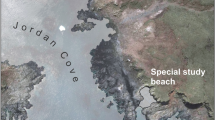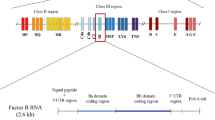Abstract
IN a study1 of the haemoglobins of Macaca irus obtained from Thailand and Vietnam two α-chain variants, electrophoretically distinguishable from the normal type (Hb-Ami), were found to be frequent. One, Hb-Qmi, was anodal to Hb-Ami on starch gel at pH 8.6 and varied considerably in relative concentration when present with the latter. The fingerprint pattern of the soluble tryptic peptides was, however, indistinguishable from that of Hb-Ami and the difference is presumably in the insoluble peptide core. The other variant, Hb-Pmi, had the same electrophoretic mobility as Hb-Qmi in very fresh haemolysates but formed aggregates with ageing so that it then appeared in starch gels as a trail extending cathodally from the Hb-Ami position. The fingerprint of Hb-Pmi was distinct from that of Hb-Ami, αT3 (tryptophan positive) and αT4 (histidine positive) being absent and a new tryptophan and histidine positive peptide appearing in the neutral region. A single amino-acid substitution in α15 or 16 would probably account for this. The phenotype frequencies of these two variants in the population were consistent with their being determined by alleles at the α-locus. In addition, about 20 per cent of the animals had a minor haemoglobin component. The distinctive chain of this component was shown2,3 to differ from the normal α-chain in at least four substitutions. In some animals the minor component was present together with Hb-Ami and either Hb-Pmi or Hb-Qmi and it was suggested that the characteristic chain arose by duplication of the α-locus and mutational divergence.
This is a preview of subscription content, access via your institution
Access options
Subscribe to this journal
Receive 51 print issues and online access
$199.00 per year
only $3.90 per issue
Buy this article
- Purchase on Springer Link
- Instant access to full article PDF
Prices may be subject to local taxes which are calculated during checkout
Similar content being viewed by others
References
Barnicot, N. A., Huehns, E. R., and Jolly, C. J., Proc. Roy. Soc., B, 165, 224 (1966).
Wade, P. T., Barnicot, N. A., and Huehns, E. R., Nature, 215, 1485 (1967).
Wade, P. T., Skinner, A., Barnicot, N. A., and Huehns, E. R., Protides of the Biological Fluids (edit. by Peeters), 263 (Pergamon, Oxford and NY, 1970).
Oliver, E., and Kitchen, H., Biochem. Biophys. Res. Commun., 31, 749 (1968).
Robinson, E. A., and Itano, H. A., Nature, 188, 798 (1960).
Author information
Authors and Affiliations
Rights and permissions
About this article
Cite this article
BARNICOT, N., WADE, P. & COHEN, P. Evidence for a Second Haemoglobin α-Locus Duplication in Macaca irus. Nature 228, 379–381 (1970). https://doi.org/10.1038/228379a0
Received:
Issue Date:
DOI: https://doi.org/10.1038/228379a0
This article is cited by
-
Hemoglobin polymorphism in macaques with reference to the evolution ofMacaca fascicularis andMacaca mulatta
Primates (1989)
-
Novel hemoglobin components and their amino acid sequences from the crab-eating macaque (Macaca fascicularis)
Journal of Molecular Evolution (1988)
-
Genetic variations within and between troops of the crab-eating macaque (Macaca fascicularis) on Sumatra, Java, Bali, Lombok and Sumbawa, Indonesia
Primates (1984)
-
Genetic differentiation of the indonesian crab-eating macaque (macaca fascicularis/it): I. Preliminary report on blood protein polymorphism
Primates (1981)
Comments
By submitting a comment you agree to abide by our Terms and Community Guidelines. If you find something abusive or that does not comply with our terms or guidelines please flag it as inappropriate.



